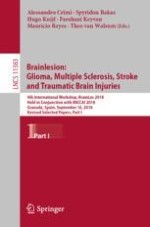This two-volume set LNCS 11383 and 11384 constitutes revised selected papers from the 4th International MICCAI Brainlesion Workshop, BrainLes 2018, as well as the International Multimodal Brain Tumor Segmentation, BraTS, Ischemic Stroke Lesion Segmentation, ISLES, MR Brain Image Segmentation, MRBrainS18, Computational Precision Medicine, CPM, and Stroke Workshop on Imaging and Treatment Challenges, SWITCH, which were held jointly at the Medical Image Computing for Computer Assisted Intervention Conference, MICCAI, in Granada, Spain, in September 2018.
The 92 papers presented in this volume were carefully reviewed and selected from 95 submissions. They were organized in topical sections named: brain lesion image analysis; brain tumor image segmentation; ischemic stroke lesion image segmentation; grand challenge on MR brain segmentation; computational precision medicine; stroke workshop on imaging and treatment challenges.
